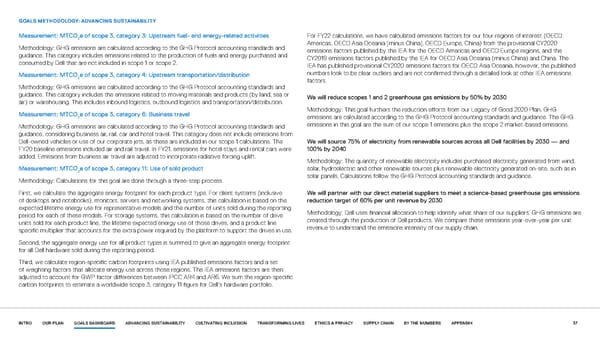GOALS METHODOLOGY: ADVANCING SUSTAINABILITY Measurement: MTCO e of scope 3, category 3: Upstream fuel- and energy-related activities For FY22 calculations, we have calculated emissions factors for our four regions of interest (OECD 2 Methodology: GHG emissions are calculated according to the GHG Protocol accounting standards and Americas, OECD Asia Oceania [minus China], OECD Europe, China) from the provisional CY2020 guidance. This category includes emissions related to the production of fuels and energy purchased and emissions factors published by the IEA for the OECD Americas and OECD Europe regions, and the consumed by Dell that are not included in scope 1 or scope 2. CY2019 emissions factors published by the IEA for OECD Asia Oceania (minus China) and China. The IEA has published provisional CY2020 emissions factors for OECD Asia Oceania, however, the published Measurement: MTCO e of scope 3, category 4: Upstream transportation/distribution numbers look to be clear outliers and are not confirmed through a detailed look at other IEA emissions 2 factors. Methodology: GHG emissions are calculated according to the GHG Protocol accounting standards and guidance. This category includes the emissions related to moving materials and products (by land, sea or We will reduce scopes 1 and 2 greenhouse gas emissions by 50% by 2030 air) or warehousing. This includes inbound logistics, outbound logistics and transportation/distribution. Measurement: MTCO e of scope 3, category 6: Business travel Methodology: This goal furthers the reduction efforts from our Legacy of Good 2020 Plan. GHG 2 emissions are calculated according to the GHG Protocol accounting standards and guidance. The GHG Methodology: GHG emissions are calculated according to the GHG Protocol accounting standards and emissions in this goal are the sum of our scope 1 emissions plus the scope 2 market-based emissions. guidance, considering business air, rail, car and hotel travel. This category does not include emissions from Dell-owned vehicles or use of our corporate jets, as these are included in our scope 1 calculations. The We will source 75% of electricity from renewable sources across all Dell facilities by 2030 — and FY20 baseline emissions included air and rail travel. In FY21, emissions for hotel stays and rental cars were 100% by 2040 added. Emissions from business air travel are adjusted to incorporate radiative forcing uplift. Methodology: The quantity of renewable electricity includes purchased electricity generated from wind, Measurement: MTCO e of scope 3, category 11: Use of sold product solar, hydroelectric and other renewable sources plus renewable electricity generated on-site, such as in 2 Methodology: Calculations for this goal are done through a three-step process. solar panels. Calculations follow the GHG Protocol accounting standards and guidance. First, we calculate the aggregate energy footprint for each product type. For client systems (inclusive We will partner with our direct material suppliers to meet a science-based greenhouse gas emissions of desktops and notebooks), monitors, servers and networking systems, this calculation is based on the reduction target of 60% per unit revenue by 2030 expected lifetime energy use for representative models and the number of units sold during the reporting Methodology: Dell uses financial allocation to help identify what share of our suppliers’ GHG emissions are period for each of these models. For storage systems, this calculation is based on the number of drive created through the production of Dell products. We compare these emissions year-over-year per unit units sold for each product line, the lifetime expected energy use of those drives, and a product line revenue to understand the emissions intensity of our supply chain. specific multiplier that accounts for the extra power required by the platform to support the drives in use. Second, the aggregate energy use for all product types is summed to give an aggregate energy footprint for all Dell hardware sold during the reporting period. Third, we calculate region-specific carbon footprints using IEA published emissions factors and a set of weighting factors that allocate energy use across those regions. The IEA emissions factors are then adjusted to account for GWP factor differences between IPCC AR4 and AR6. We sum the region-specific carbon footprints to estimate a worldwide scope 3, category 11 figure for Dell’s hardware portfolio. INTRO OUR PLAN GOALS DASHBOARD ADVANCING SUSTAINABILITY CULTIVATING INCLUSION TRANSFORMING LIVES ETHICS & PRIVACY SUPPLY CHAIN BY THE NUMBERS APPENDIX 37
 Our purpose in action | Dell Page 36 Page 38
Our purpose in action | Dell Page 36 Page 38